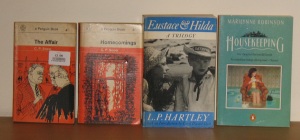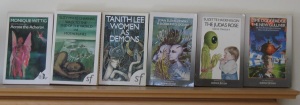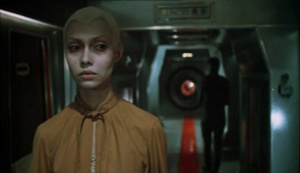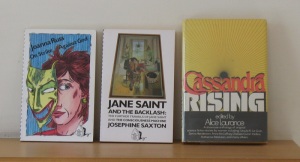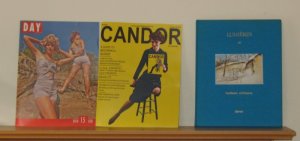Still not reading as much as I’d like – I’m currently seven books behind on the 150 book challenge, according to goodreads.com – but it’s not a bad spread in this post… Incidentally, I’m still alternative genders in my fiction reading, and it currently stands at 37% women writers, 33% men.
 Pale Fire*, Vladimir Nabokov (1962). Though I’ve seen Kubrick’s Lolita, and Nabokov is hardly a name unfamiliar to me, I’d never actually read any of his books. So I’m always on the look-out for copies of his novels in charity days. Except he doesn’t seem to be an author whose books are discarded much. But I did find Pale Fire – in Harrogate, no less – so of course I snapped it up. The back-cover copy makes quite a meal of descrbing Pale Fire as “an extraordinary, uncategorizable book”, which might well have been true in 1962 but feels a bit like over-selling in the twenty-first century. The story is told in the form of an introduction to a narrative poem, then the poem itself, and followed by copious (more than copious) notes on the poem. The author of the introduction and notes is not the author of the poem, but claims to have been the poet’s closest friend in the year leading up to his murder. Two things occurred to me as I read the book: a) the poem is actually complete doggerel, and b) the narrative voice reminded me throughout of Adam Roberts’s prose (there’s a particular line, “The crickets cricked”, which felt like it could have come from any random Roberts story). Threaded throughout the notes is the commentator’s own history, which involves some sort of Mittel-Europa principality whose monarchy was violently overthrown. The Appalachian academia and the Ruritanian adventure make for interesting bedfellows, and the prissy prose fitted the story extremely well. I liked it a lot and I plan to read more Nabokov.
Pale Fire*, Vladimir Nabokov (1962). Though I’ve seen Kubrick’s Lolita, and Nabokov is hardly a name unfamiliar to me, I’d never actually read any of his books. So I’m always on the look-out for copies of his novels in charity days. Except he doesn’t seem to be an author whose books are discarded much. But I did find Pale Fire – in Harrogate, no less – so of course I snapped it up. The back-cover copy makes quite a meal of descrbing Pale Fire as “an extraordinary, uncategorizable book”, which might well have been true in 1962 but feels a bit like over-selling in the twenty-first century. The story is told in the form of an introduction to a narrative poem, then the poem itself, and followed by copious (more than copious) notes on the poem. The author of the introduction and notes is not the author of the poem, but claims to have been the poet’s closest friend in the year leading up to his murder. Two things occurred to me as I read the book: a) the poem is actually complete doggerel, and b) the narrative voice reminded me throughout of Adam Roberts’s prose (there’s a particular line, “The crickets cricked”, which felt like it could have come from any random Roberts story). Threaded throughout the notes is the commentator’s own history, which involves some sort of Mittel-Europa principality whose monarchy was violently overthrown. The Appalachian academia and the Ruritanian adventure make for interesting bedfellows, and the prissy prose fitted the story extremely well. I liked it a lot and I plan to read more Nabokov.
 Soyuz: Owners’ Workshop Manual, David Baker (2014). Sadly, this is not an owners’ workshop manual for Soyuz spacecraft in the same form as the owners’ workshop manuals Haynes has been publishing for various cars for decades. It won’t teach you how to change a leaky valve or an oxygen tank. If your Soyuz breaks down in orbit, even if you have a copy of this book with you, you’re still pretty much fucked. It is, however, a pretty comprehensive look at Russian crewed spacecraft, from Vostok through Voskhod and the various iterations of Soyuz, in pretty impressive factual detail. I found it all fascinating, but I suspect the book will also prove to be a useful reference for any future stories I might write involving Soyuz space craft. There are similar Haynes manuals for Gemini, Space Shuttle, Lunar Rover and, er, Millennium Falcon.
Soyuz: Owners’ Workshop Manual, David Baker (2014). Sadly, this is not an owners’ workshop manual for Soyuz spacecraft in the same form as the owners’ workshop manuals Haynes has been publishing for various cars for decades. It won’t teach you how to change a leaky valve or an oxygen tank. If your Soyuz breaks down in orbit, even if you have a copy of this book with you, you’re still pretty much fucked. It is, however, a pretty comprehensive look at Russian crewed spacecraft, from Vostok through Voskhod and the various iterations of Soyuz, in pretty impressive factual detail. I found it all fascinating, but I suspect the book will also prove to be a useful reference for any future stories I might write involving Soyuz space craft. There are similar Haynes manuals for Gemini, Space Shuttle, Lunar Rover and, er, Millennium Falcon.
 The Silkworm, Robert Galbraith (2014). I wasn’t that impressed with Rowling’s first pseudonymous crime novel, The Cuckoo’s Calling, nor, as far as I remember, was anyone else. The book sold modestly, and received a handful of good reviews – which is pretty much what you would expect from a debut crime novel. Strange then, that the back cover of her second Galbraith novel, The Silkworm, boasts quotes about The Cuckoo’s Calling such as “One of the most unique and compelling detectives I’ve come across in years” and “One of the best crime novels I have ever read”… Which suggests crime fiction must be in dire straits, or Rowling’s name really does affect how people – even reviewers in newspapers – judge books. I thought The Cuckoo’s Calling somewhat padded, but The Silkworm at least feels like its the right length. It’s also about the publishing industry, something you’d imagine Rowling would know about since she is, after all, a best-selling author. The actual crime investigated by Cormoran Strike, however, seems more like something from an episode of CSI. A woman hires Strike to find her missing novelist husband, Owen Quine. He’s done it before, but his agent usually tracks him down quite quickly. But this time Quine seems to have really vanished. Making matters worse is the fact his new book is libellous (shades of Burgess’s The Worm & the Ring) and more or less unpublishable. It doesn’t Strike long to find Quine – or rather, his body. And his corpse has been mutilated in a manner which links back to his manuscript. There’s nothing startlingly original here – the plot moves on well-oiled wheels, the characters teeter on the brink of caricature but Galbraith manages to rein them in, and the prose is smooth and readable without being too literary for a crime novel or too commercial for those who prefer their crime novels to have some ambition. The novelists at the centre of the plot were all literary enfants terribles, and though mostly well-respected now their novels as described don’t much read like twenty-first century British literary fiction. Oh, and the title is a reference to Quine’s unpublishable novel, Bombyx Mori, which title only seems to exist because it justifies a particularly gruesome murder.
The Silkworm, Robert Galbraith (2014). I wasn’t that impressed with Rowling’s first pseudonymous crime novel, The Cuckoo’s Calling, nor, as far as I remember, was anyone else. The book sold modestly, and received a handful of good reviews – which is pretty much what you would expect from a debut crime novel. Strange then, that the back cover of her second Galbraith novel, The Silkworm, boasts quotes about The Cuckoo’s Calling such as “One of the most unique and compelling detectives I’ve come across in years” and “One of the best crime novels I have ever read”… Which suggests crime fiction must be in dire straits, or Rowling’s name really does affect how people – even reviewers in newspapers – judge books. I thought The Cuckoo’s Calling somewhat padded, but The Silkworm at least feels like its the right length. It’s also about the publishing industry, something you’d imagine Rowling would know about since she is, after all, a best-selling author. The actual crime investigated by Cormoran Strike, however, seems more like something from an episode of CSI. A woman hires Strike to find her missing novelist husband, Owen Quine. He’s done it before, but his agent usually tracks him down quite quickly. But this time Quine seems to have really vanished. Making matters worse is the fact his new book is libellous (shades of Burgess’s The Worm & the Ring) and more or less unpublishable. It doesn’t Strike long to find Quine – or rather, his body. And his corpse has been mutilated in a manner which links back to his manuscript. There’s nothing startlingly original here – the plot moves on well-oiled wheels, the characters teeter on the brink of caricature but Galbraith manages to rein them in, and the prose is smooth and readable without being too literary for a crime novel or too commercial for those who prefer their crime novels to have some ambition. The novelists at the centre of the plot were all literary enfants terribles, and though mostly well-respected now their novels as described don’t much read like twenty-first century British literary fiction. Oh, and the title is a reference to Quine’s unpublishable novel, Bombyx Mori, which title only seems to exist because it justifies a particularly gruesome murder.
 Mortal Engines, Stanisław Lem (1977). I somehow got it into my head I needed to read more Lem, but I suspect I like the idea of Lem more than I like the fiction of Lem. Which is not to say this collection of short stories is bad. But I can’t say I agree with the person who collated the collection, Michael Kandel, who loves Lem’s “robot fables” so much he chose to bring them all together into one book. Because while they’re clever little fairy tales, with one or two clever puns, they do get a bit wearying en masse. Happily, the book is rounded off with an Ijon Tichy story, a Pilot Pirx story, and one which is completely unrelated to the others in the book but is still about robots. This is not the best sf collection in the world, and even Lem’s snide bleakness can’t hide the datedness of some of the stories. I suspect this one might end up as a raffle prize at one of the pub meets some time next year…
Mortal Engines, Stanisław Lem (1977). I somehow got it into my head I needed to read more Lem, but I suspect I like the idea of Lem more than I like the fiction of Lem. Which is not to say this collection of short stories is bad. But I can’t say I agree with the person who collated the collection, Michael Kandel, who loves Lem’s “robot fables” so much he chose to bring them all together into one book. Because while they’re clever little fairy tales, with one or two clever puns, they do get a bit wearying en masse. Happily, the book is rounded off with an Ijon Tichy story, a Pilot Pirx story, and one which is completely unrelated to the others in the book but is still about robots. This is not the best sf collection in the world, and even Lem’s snide bleakness can’t hide the datedness of some of the stories. I suspect this one might end up as a raffle prize at one of the pub meets some time next year…
The Monitor, the Miners and the Shree, Lee Killough (1980). That’s a pretty awful title for a book that’s actually not that bad. Not as enjoyable as A Voice Out of Ramah (see here), but certainly not awful. A review to appear soon on SF Mistressworks.
 Slade House, David Mitchell (2015). I was sent an ARC of this by Interzone to review (they also wanted to send me a copy of The Bone Clocks, but I’d already bought one – using a voucher given to me by my employer as a reward for five years of service). Overall, I don’t think Slade House is as successful as The Bone Clocks, and that’s not just a consequence of its significantly shorter length. Mitchell’s trademark ventriloquism is in fine, er, voice, but the fifth of its six sections is almost pure exposition, some of the tropes are a bit cheesy, and the whole thing doesn’t add anything of note to the mythology of The Bone Clocks. Which is not to say it’s a bad book – Mitchell is a fine writer and always worth reading – but it is a little disappointing after last year’s epic.
Slade House, David Mitchell (2015). I was sent an ARC of this by Interzone to review (they also wanted to send me a copy of The Bone Clocks, but I’d already bought one – using a voucher given to me by my employer as a reward for five years of service). Overall, I don’t think Slade House is as successful as The Bone Clocks, and that’s not just a consequence of its significantly shorter length. Mitchell’s trademark ventriloquism is in fine, er, voice, but the fifth of its six sections is almost pure exposition, some of the tropes are a bit cheesy, and the whole thing doesn’t add anything of note to the mythology of The Bone Clocks. Which is not to say it’s a bad book – Mitchell is a fine writer and always worth reading – but it is a little disappointing after last year’s epic.
1001 Books You Must Read Before You Die count: 117



